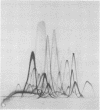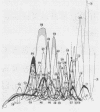Abstract
Quantitative immunoelectrophoresis allows a polyvalent approach to immuno-chemical problems, i.e., identification, quantitation, and thereby standardization of antigens and antibodies in complex mixtures, for example as in crude extracts of microorganisms and their corresponding antisera. This approach is a short cut to conventional standardization of single purified substances, since the polyvalent approach gives a precise quantitative impression as described in this investigation and therefore enables the immunochemist to precisely select the right substance(s) to be purified for further standardization and characterization. To secure the precision of the results, in complex systems it is a sine qua non to select a complex antibody standard, a complex antigen standard, and to describe the complex standard precipitate pattern which again allows a quantitative study of the reproducibility of methods and procedures. The present article describes how such a standardization was approached in this laboratory within the field of Candida albicans immunochemistry. By means of crossed immunoelectrophoresis, 78 water-soluble antigens were demonstrated and enumerated in an antigen standard prepared from one strain of C. albicans A (B 311 Hasenclever). The antibody standard consisted of purified and concentrated rabbit antibodies. The migration velocity of each antigen was indicated in relation to purified human albumin. Not all precipitates could be seen in one immunoplate; therefore a standardized procedure was worked out showing reproducibly 54 precipitates. The reproducibility of quantitation by the crossed-immunoelectrophoresis procedure was determined for each of 30 antigens by repeated measurements; the relative standard deviations ranged from 2.4 to 15.4% and were below 10% for 24 antigens. A simple standardized antigen production procedure was described in great detail, and by quantitative determinations on 30 antigens the procedure was found to be satisfactorily reproducible. By means of crossed-line immunoelectrophoresis in the modification called absorption of antibodies in situ, it was found that strain B 311 contained no specific antigens in comparison to eight other strains of C. albicans. Thirty antigens were quantitated in antigen preparations made by the standardized procedure from the eight strains, and each antigen concentration was expressed as a percentage of the antigen standard. For each antigen a significant inter-strain variation was observed. Of 30 antigens, fifteen were satisfactorily stable after storage at −20 C for 1½ years. The laboratory methods and procedures described in this article thus work with high precision and allow a rapid collection of quantitative data concerning many individual antigens and their corresponding antibodies without purification of antigens. A new complex antigen standard can be made with satisfactory precision from strain B 311. The production of a similar complex antibody standard is a major problem; therefore the main problem in the intra-laboratory standardization seems to be the change from one complex standard to another. In inter-laboratory standardization on the complex level, there seems to be a minimum demand that the first laboratory distributes the antibody standard and that other laboratories use the methods and procedures of the first laboratory.
Full text
PDF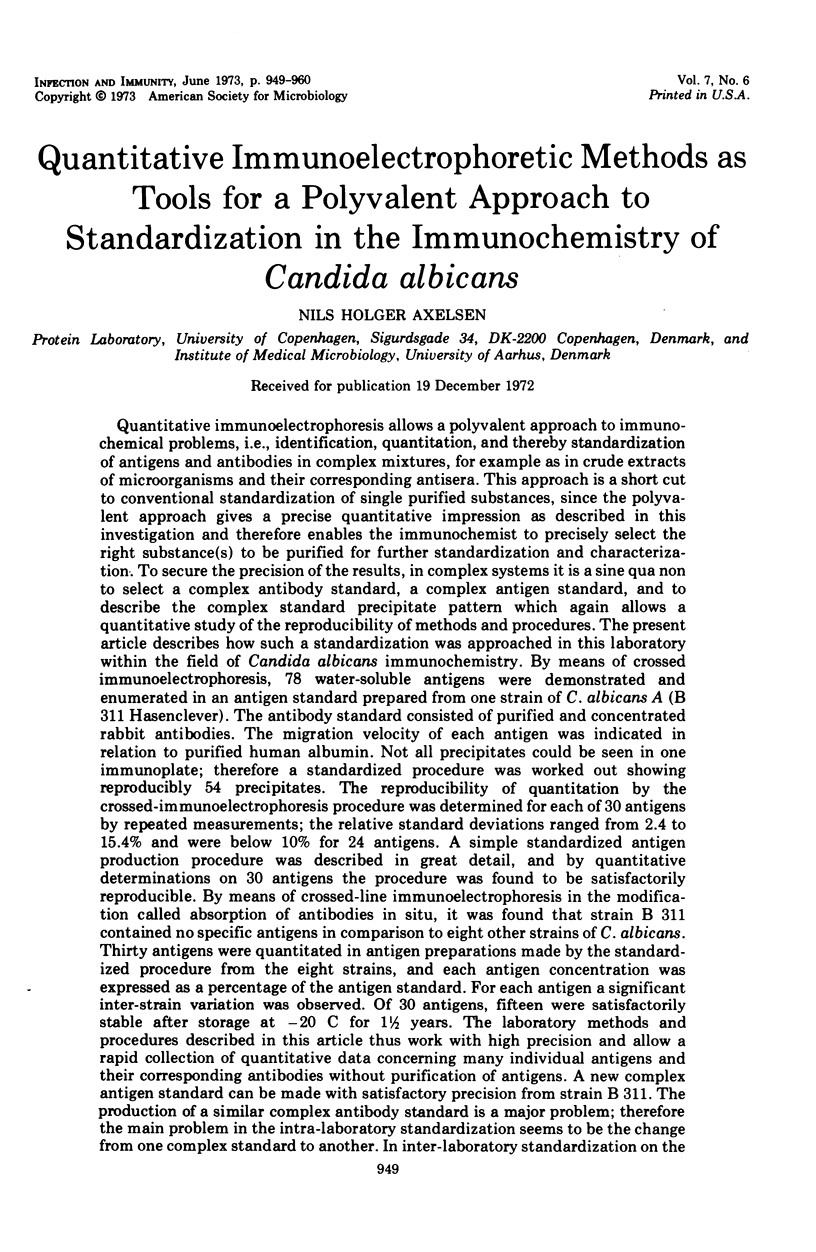
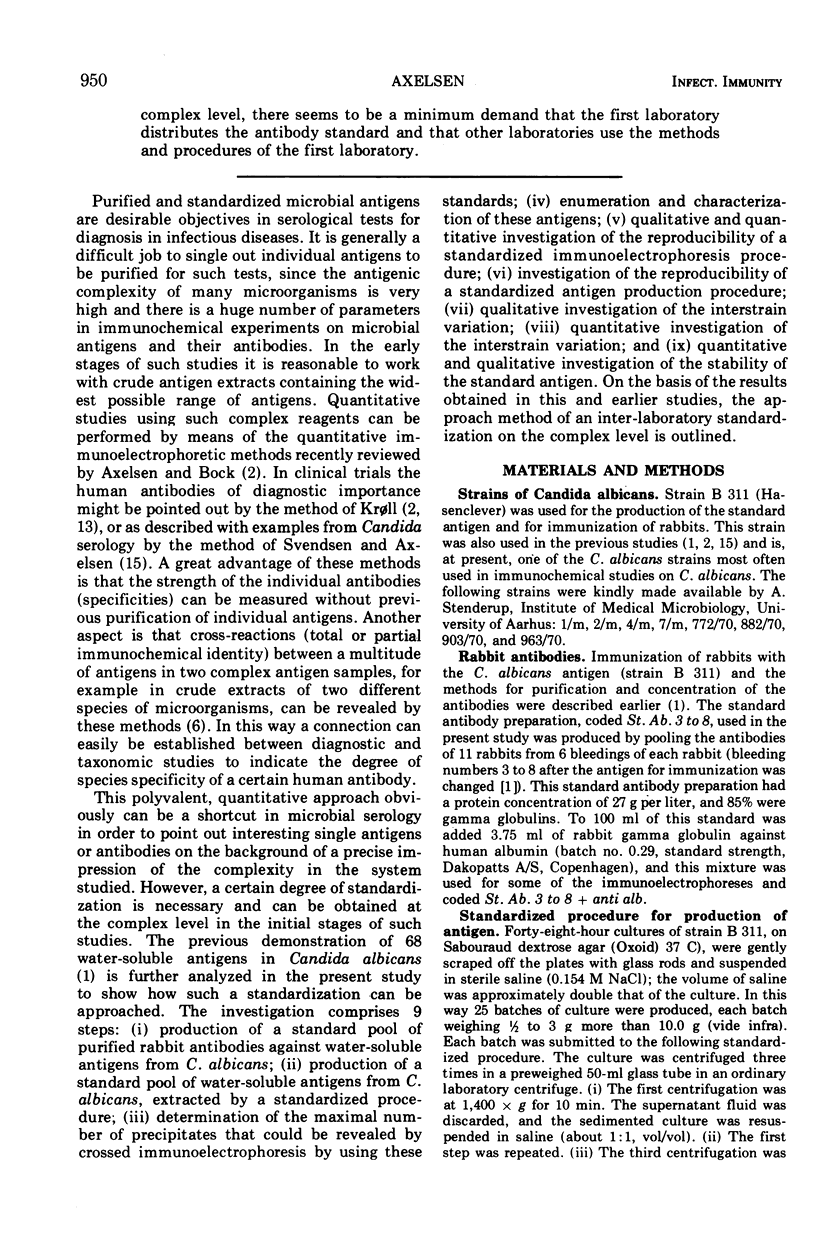
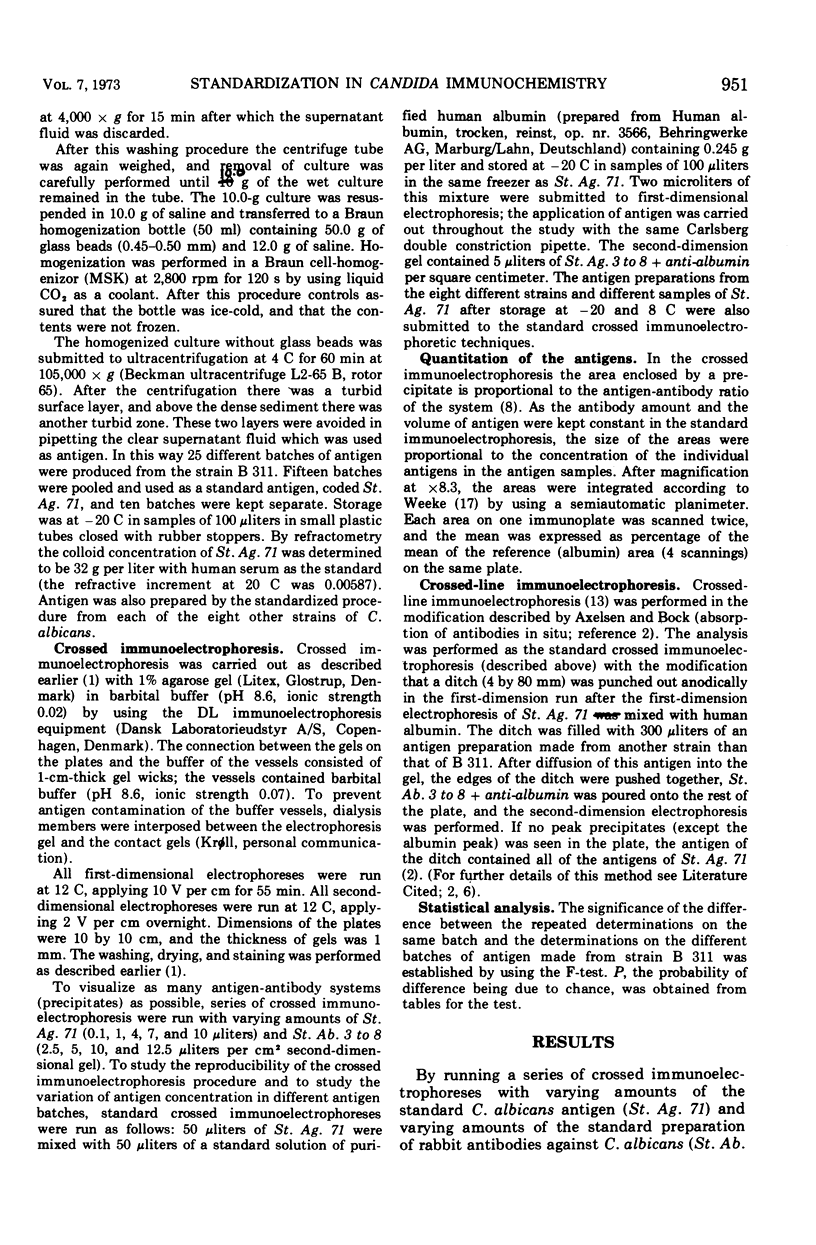
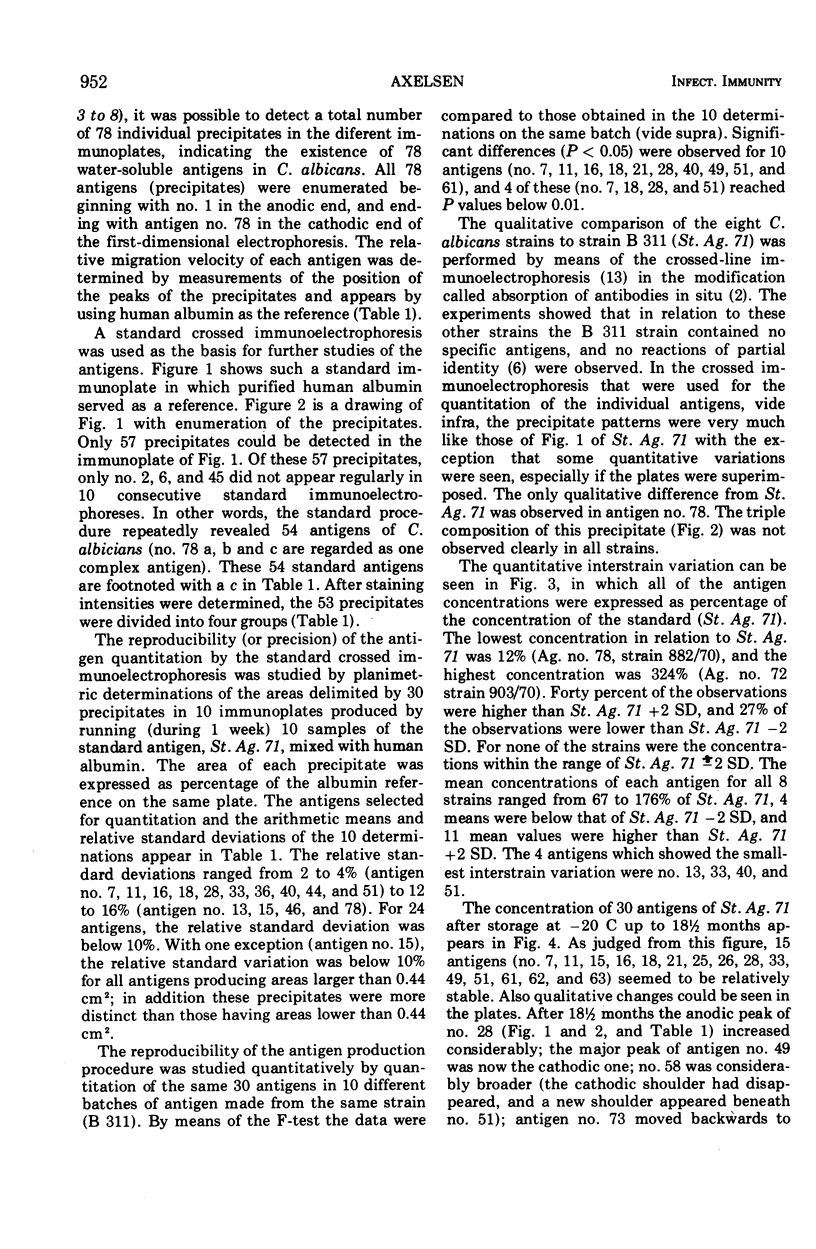
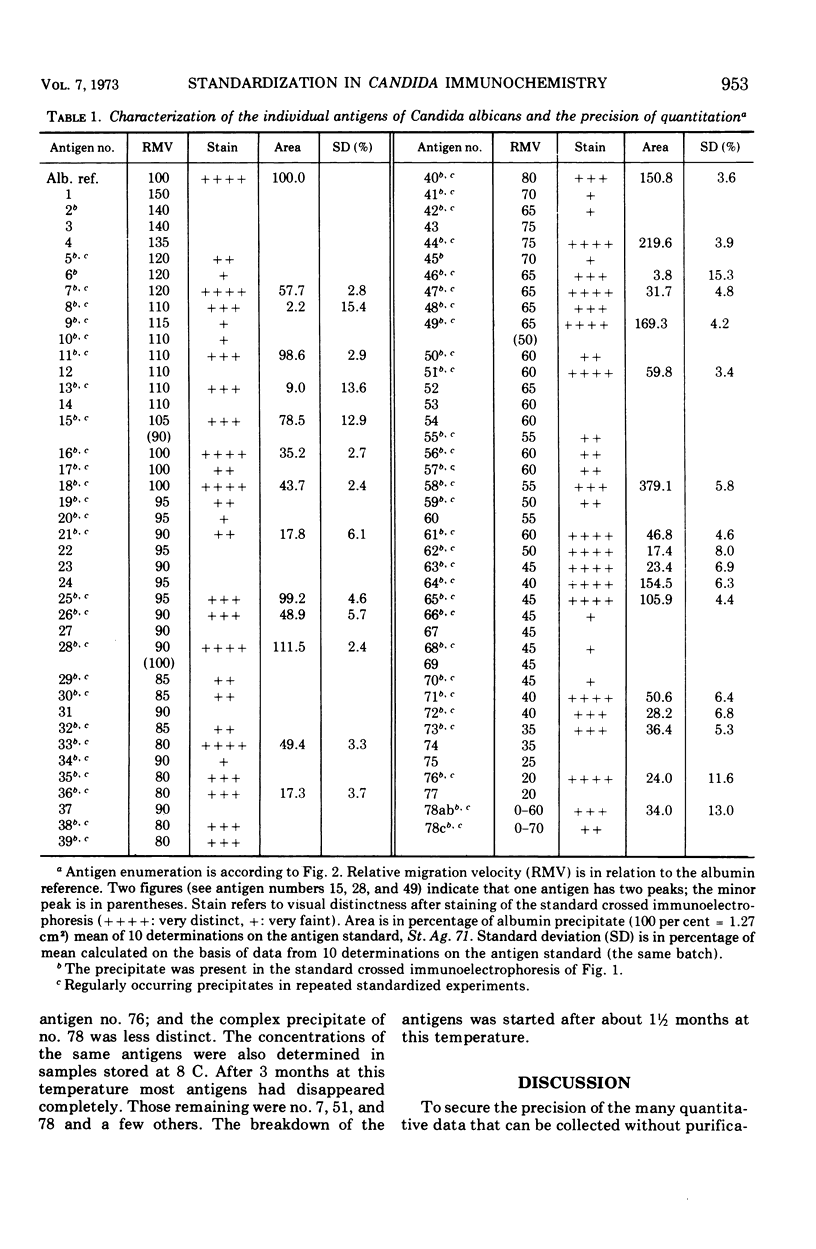
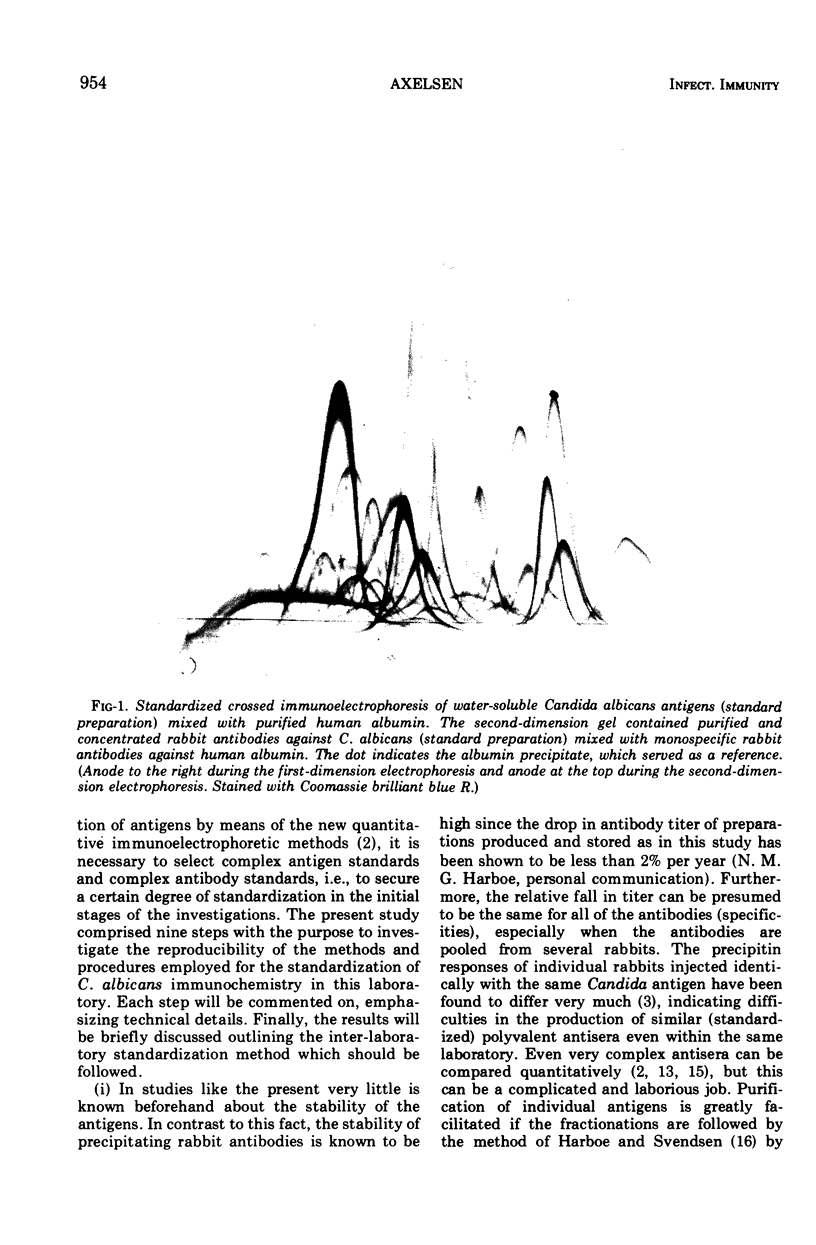
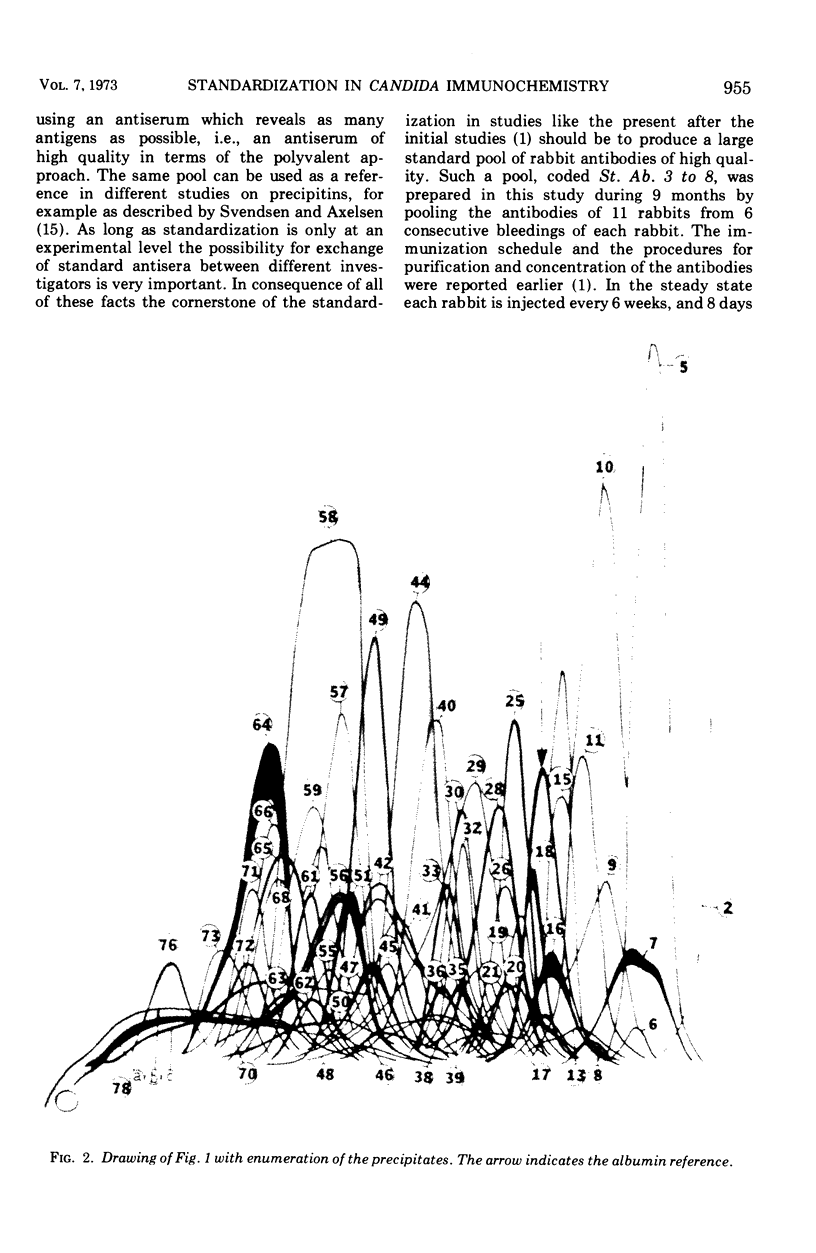
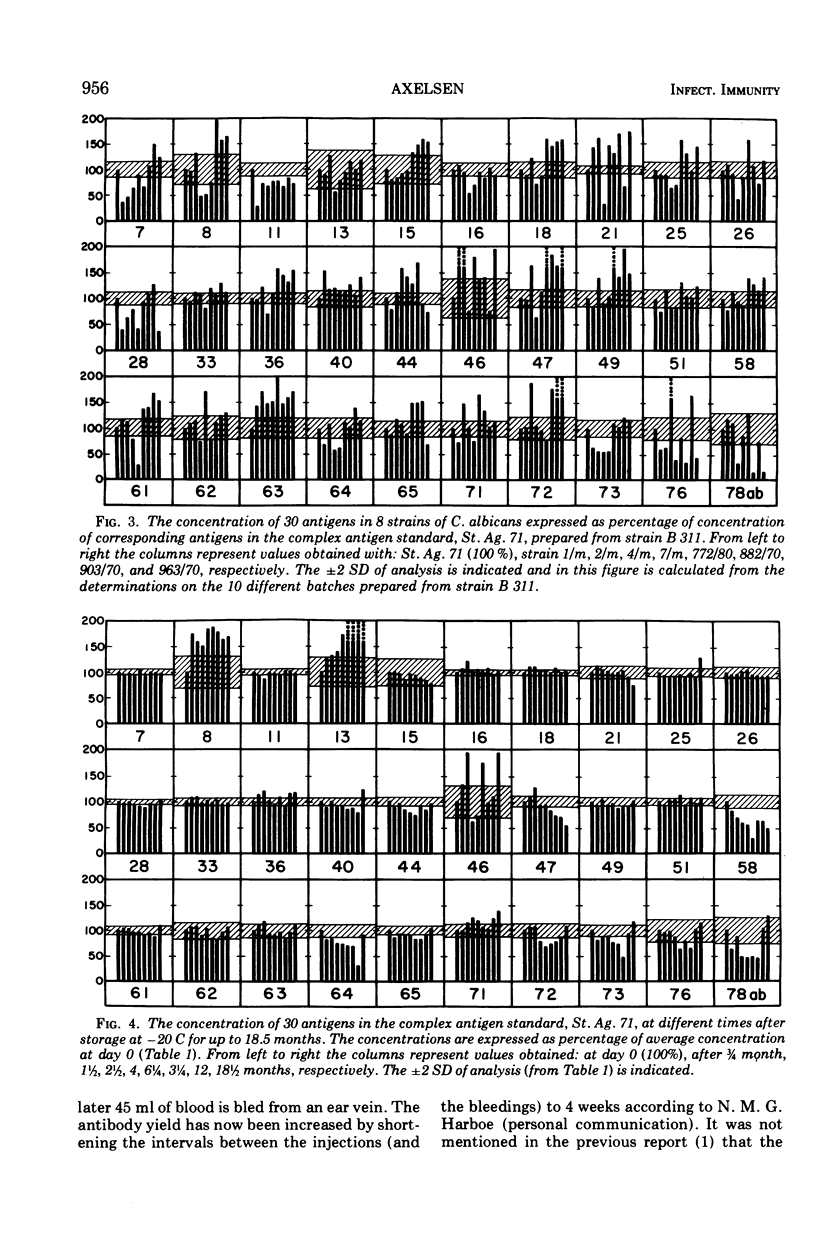
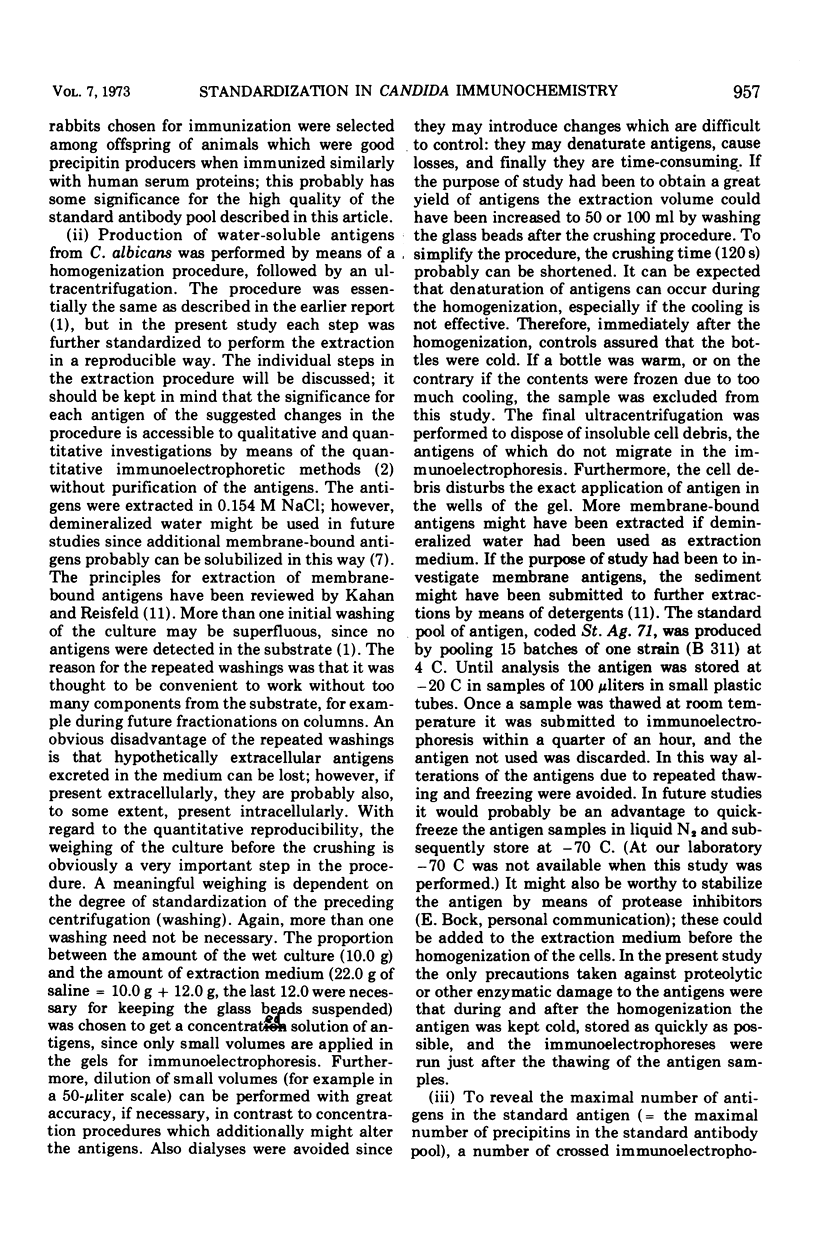
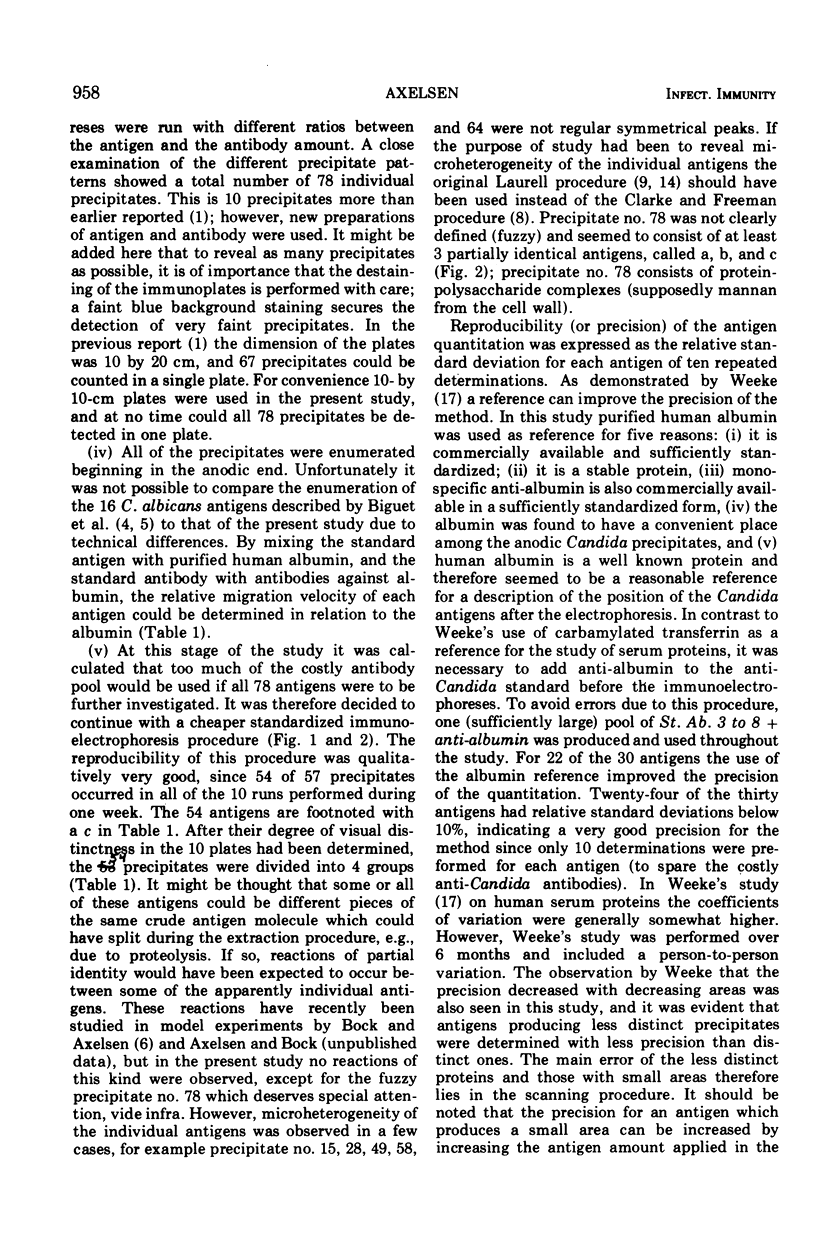
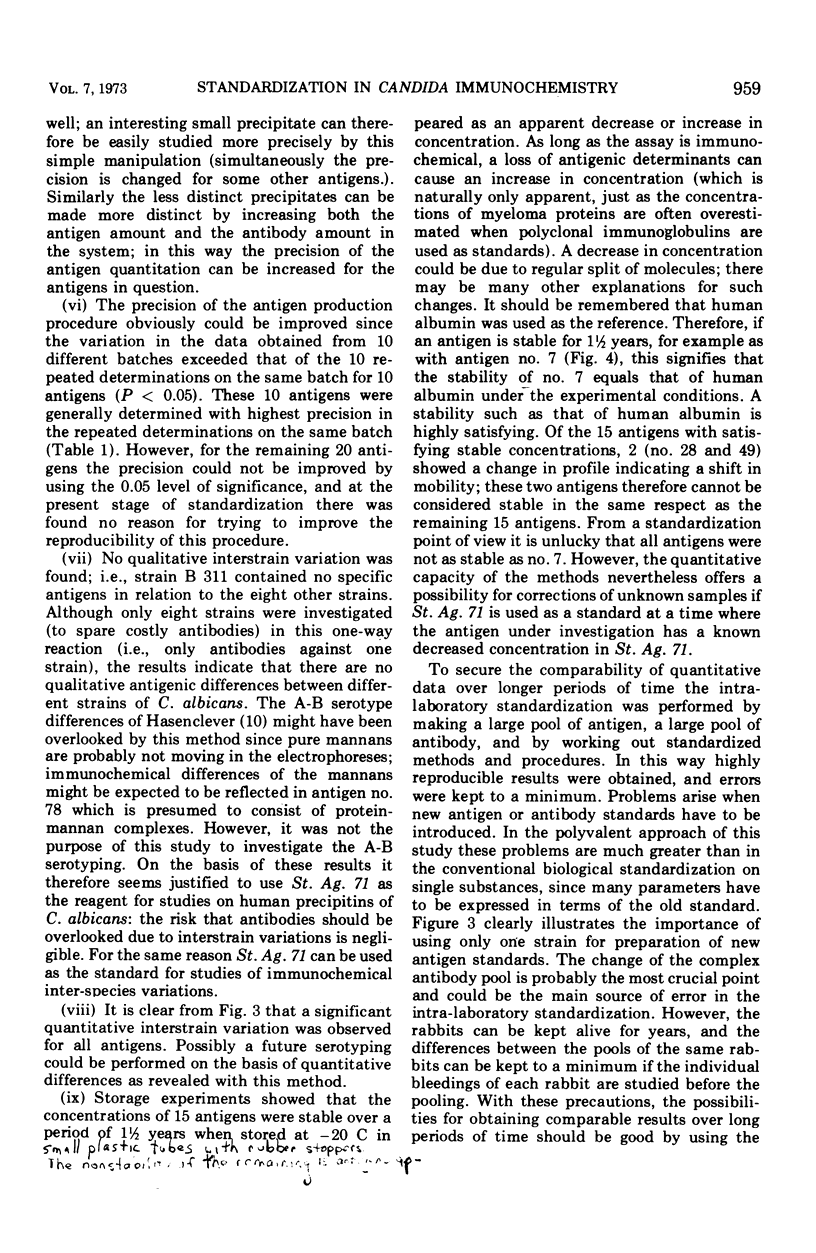
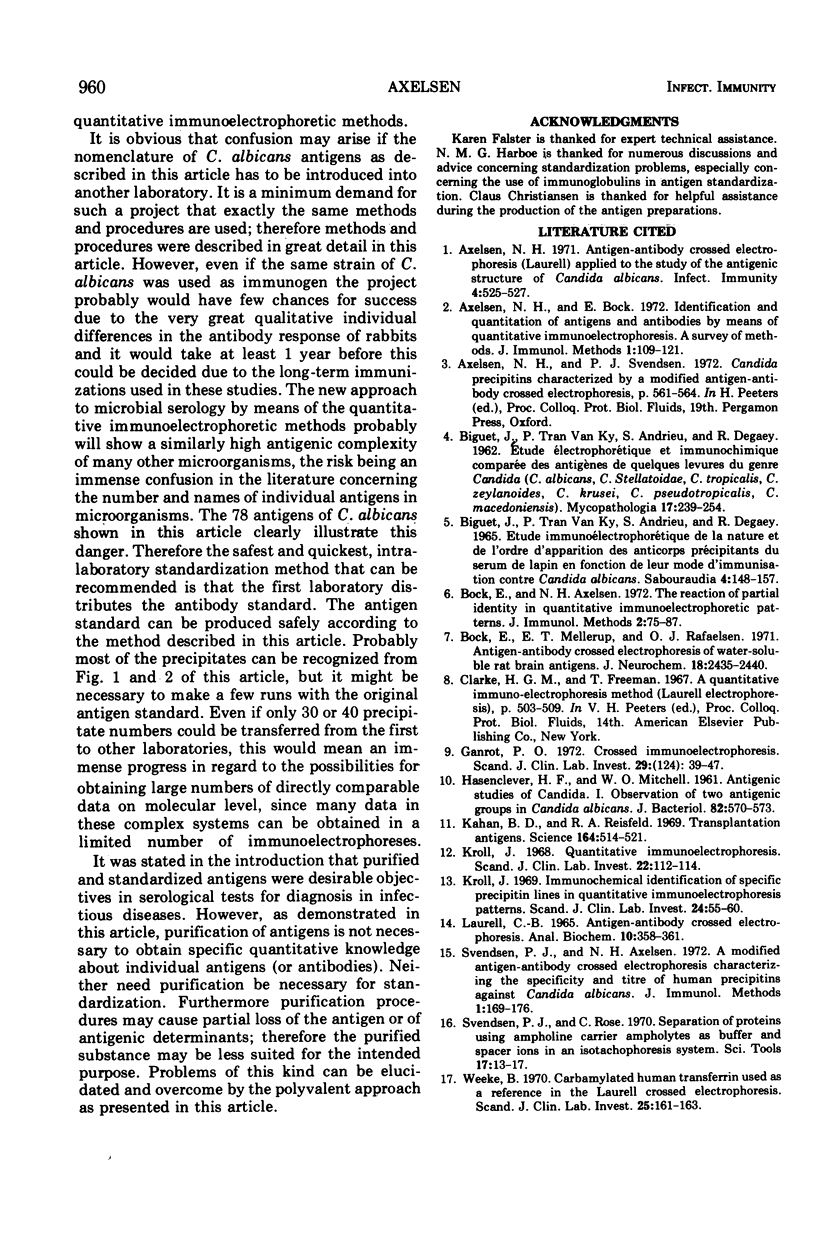
Images in this article
Selected References
These references are in PubMed. This may not be the complete list of references from this article.
- Axelsen N. H. Antigen-antibody crossed electrophoresis (Laurell) applied to the study of the antigenic structure of Candida albicans. Infect Immun. 1971 Nov;4(5):525–527. doi: 10.1128/iai.4.5.525-527.1971. [DOI] [PMC free article] [PubMed] [Google Scholar]
- Axelsen N. H., Bock E. Identification and quantitation of antigens and antibodies by means of quantitative immunoelectrophoresis. A survey of methods. J Immunol Methods. 1972 Jan;1(2):109–121. doi: 10.1016/0022-1759(72)90038-5. [DOI] [PubMed] [Google Scholar]
- Biguet J., Tran Van Ky P., Andrieu S., Degaey R. Etude immunélectrophorétique de la nature et de l'ordre d'apparition des anticorps précipitants du sérum de lapins en fonction de leur mode d'immunisation contre Candida albicans. Sabouraudia. 1965 Oct;4(3):148–157. [PubMed] [Google Scholar]
- Bock E., Axelsen N. H. The reaction of partial identity in quantitative immunoelectrophoretic patterns. J Immunol Methods. 1972 Nov;2(1):75–87. doi: 10.1016/0022-1759(72)90020-8. [DOI] [PubMed] [Google Scholar]
- Bock E., Mellerup E. T., Rafaelsen O. J. Antigen-antibody crossed electrophoresis of water-soluble rat brain antigens. J Neurochem. 1971 Dec;18(12):2435–2440. doi: 10.1111/j.1471-4159.1971.tb00199.x. [DOI] [PubMed] [Google Scholar]
- Ganrot P. O. Crossed immunoelectrophoresis. Scand J Clin Lab Invest Suppl. 1972;124:39–47. doi: 10.3109/00365517209102749. [DOI] [PubMed] [Google Scholar]
- HASENCLEVER H. F., MITCHELL W. O. Antigenic studies of Candida. I. Observation of two antigenic groups in Candida albicans. J Bacteriol. 1961 Oct;82:570–573. doi: 10.1128/jb.82.4.570-573.1961. [DOI] [PMC free article] [PubMed] [Google Scholar]
- Kahan B. D., Reisfeld R. A. Transplantaton antigens. Science. 1969 May 2;164(3879):514–521. doi: 10.1126/science.164.3879.514. [DOI] [PubMed] [Google Scholar]
- Kroll J. Quantitative immunoelectrophoresis. Scand J Clin Lab Invest. 1968;22(2):112–114. doi: 10.3109/00365516809160954. [DOI] [PubMed] [Google Scholar]
- Kröll J. Immunochemical identification of specific precipitin lines in quantitative immunoelectrophoresis patterns. Scand J Clin Lab Invest. 1969 Aug;24(1):55–60. doi: 10.3109/00365516909080132. [DOI] [PubMed] [Google Scholar]
- LAURELL C. B. ANTIGEN-ANTIBODY CROSSED ELECTROPHORESIS. Anal Biochem. 1965 Feb;10:358–361. doi: 10.1016/0003-2697(65)90278-2. [DOI] [PubMed] [Google Scholar]
- Svendsen J., Axelsen N. H. A modified antigen--antibody crossed electrophoresis characterizing the specificity and titre of human precipiting against Candida albicans. J Immunol Methods. 1972 Jan;1(2):169–176. doi: 10.1016/0022-1759(72)90044-0. [DOI] [PubMed] [Google Scholar]
- Weeke B. Carbamylated human transferrin used as a reference in the Laurell crossed electrophoresis. Scand J Clin Lab Invest. 1970 Mar;25(2):161–163. doi: 10.3109/00365517009049198. [DOI] [PubMed] [Google Scholar]



